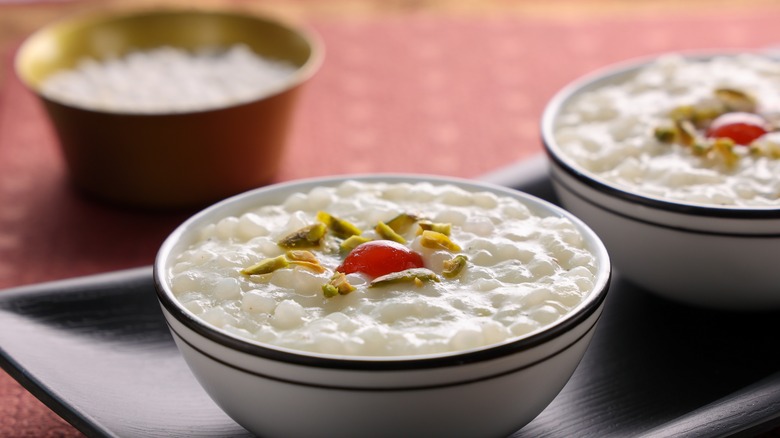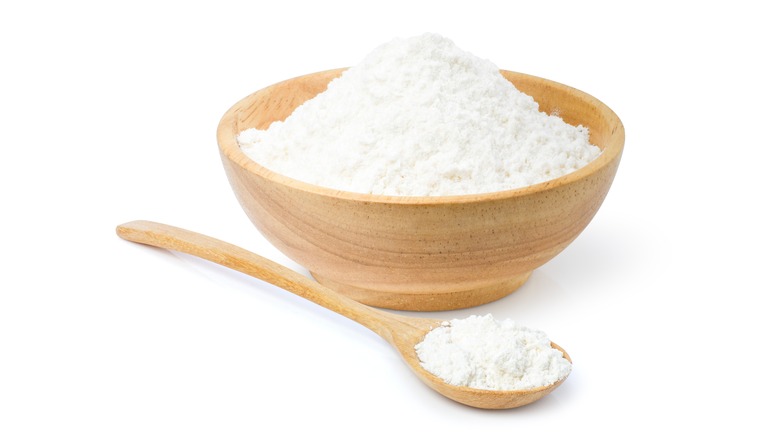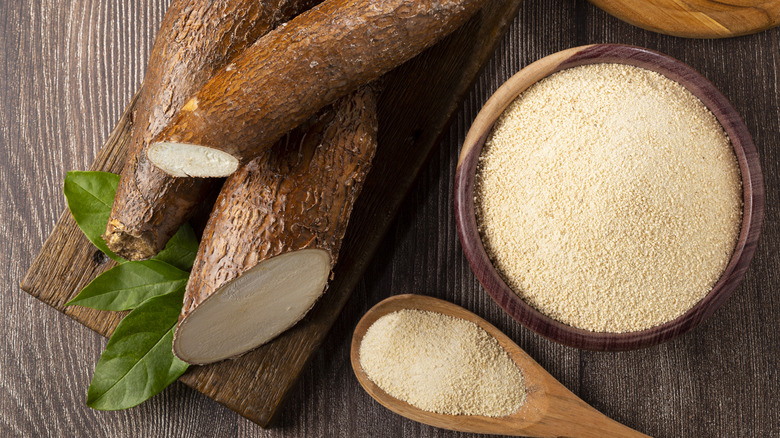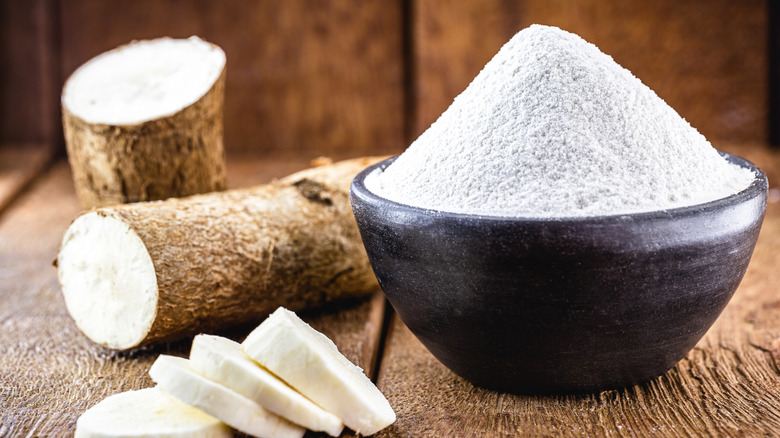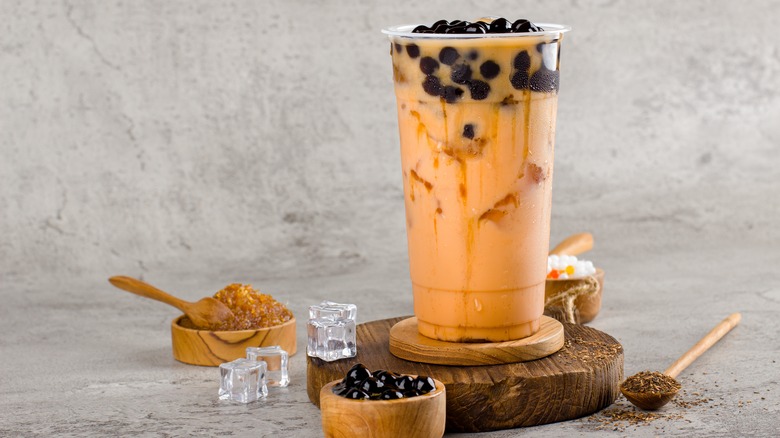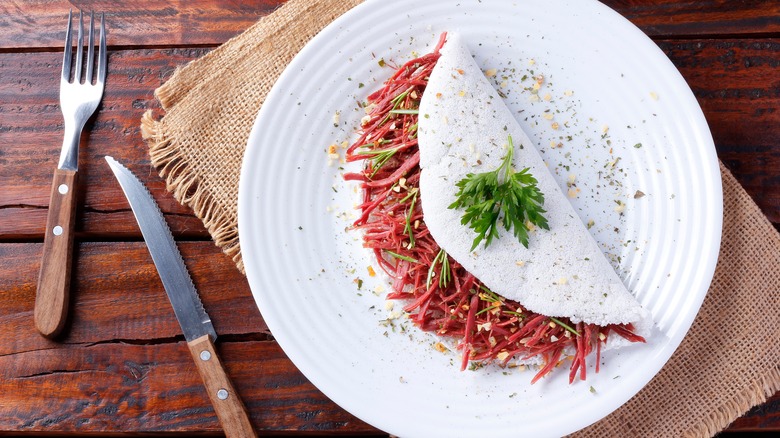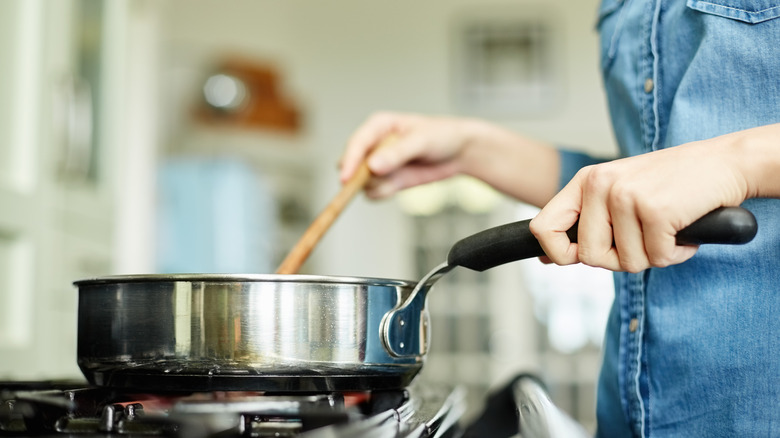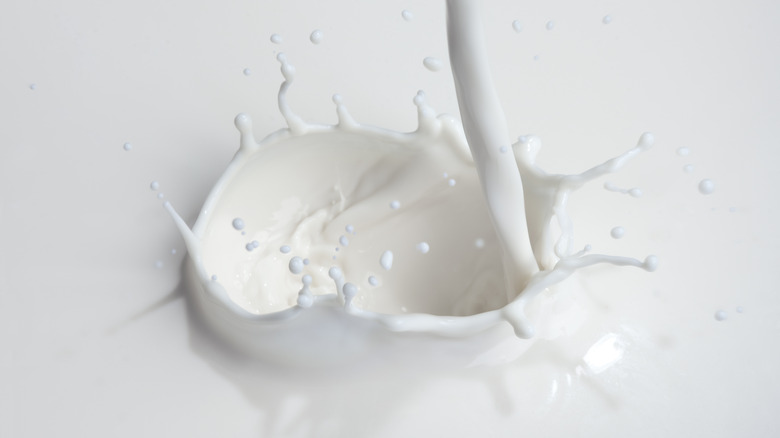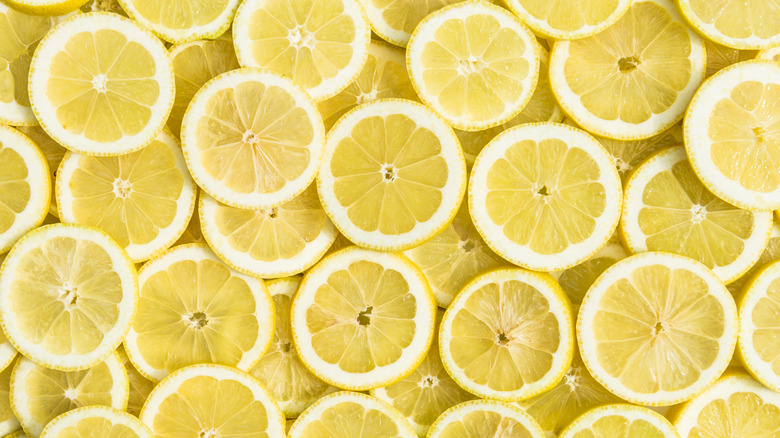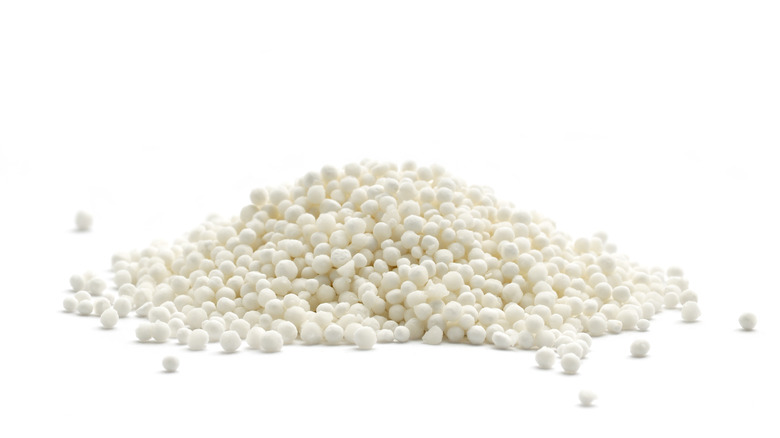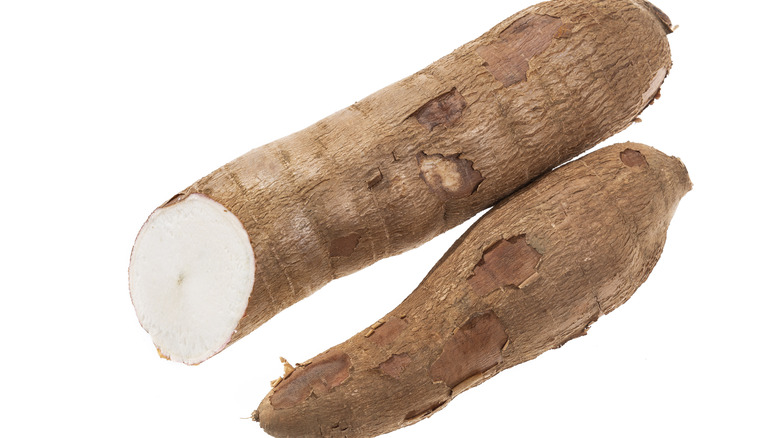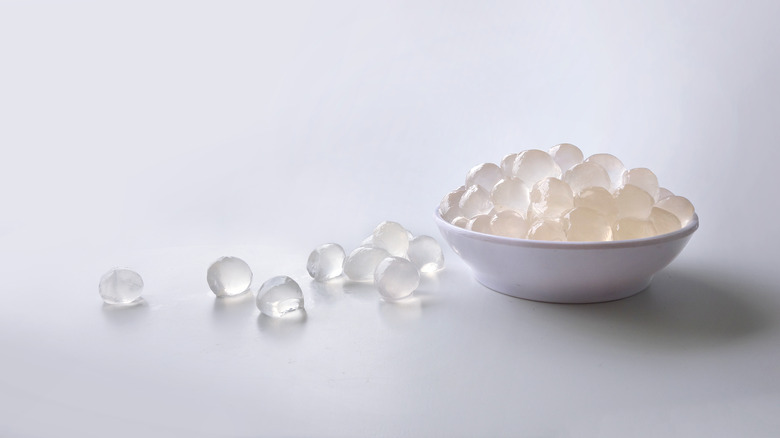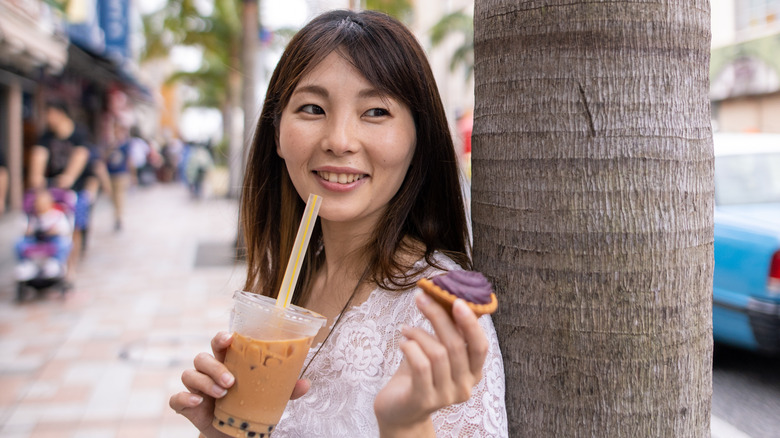What Is Tapioca And How Do You Cook With It?
We may receive a commission on purchases made from links.
Made of the cassava plant (Manihot esculenta), tapioca has sadly fallen into obscurity. While desserts such as banana bread, tiramisu, and even boxed brownies have retained their hallowed status in American society for decades, not so with tapioca.
True, you can still find recipes for it on food blogs and in cookbooks, but it doesn't have nearly the same reputation as chocolate pudding when it comes to refrigerated sweet treats, and most of us no longer encounter it at the end of a meal with friends. In fact, some people don't even know what it is, confusing it with rice pudding or remaining totally ignorant of its existence.
So what is it made of and how do you cook with it? These are questions to which everyone should know the answer. Once you understand the true nature of this delicious ingredient, you can reinstate it as an afternoon snack, delicious post-meal dessert, or classic tummy-soothing food. You may be surprised by how quickly it becomes a household favorite.
What is tapioca?
The question of what tapioca is has two possible answers, because it is both an ingredient and a dish. The ingredient tapioca is available as a powdered starch, which you can cook into small tapioca balls if you are really, really (really) motivated. However, since tapioca is also available pre-balled, most people don't bother. You can buy it both as boba balls for tea or pearls for pudding, or even as flakes in some places.
As a dish, the generic term "tapioca" refers to tapioca pudding. This is a creamy dessert with standard ingredients such as milk and/or cream, sugar, and vanilla, with the noteworthy addition of tapioca pearls: chewy, semitranslucent balls sized to between ⅛ and ¼ inches. It is sometimes flavored with other ingredients, such as booze, chocolate, or citrus. Tapioca has fallen out of favor in recent decades, but you can still find premade pudding in cups or tubs as well as pudding mix in stores.
What is tapioca made from?
Tapioca is a starch, a white powder that you can buy in a package, akin to corn or potato starch. It is made from cassava, a hefty root that kind of looks like a sweet potato or yam, for good reason: it is in the same family. Cassava has darker, rougher skin than potatoes or sweet potatoes, appearing closer to tree bark. It is frequently larger as well, and often sold with the ends chopped off, exposing the white flesh.
You make tapioca starch by pulping the root of the plant, squeezing it to extract the thick milky liquid, and then drying the liquid into a white powder. It's important to note that tapioca is not a flour, even when it looks like one; it is a dried and pulverized starch. When the cassava plant is ground whole, it becomes cassava flour, which is popularly used in making African dishes such as fufu.
If you are looking for tapioca starch, appropriate for making tapioca pearls or using as a thickener, then make sure the label says "starch." If you are looking for tapioca flour for use in baked goods, then look for a label that says "flour."
Tapioca around the world
The cassava plant hails from South America and the Caribbean. Its name originates from the word, roughly translating as "sediment," that Brazil's coastal Tupi people used to refer to the starch: tipi'óka. However, it is now widely grown across the equatorial belt of the world. Today, it now provides a staple food for more than 800 million people, according to the Food and Agriculture Organization of the United Nations.
In South America, people often turn tapioca into thin cakes, while it is common in Asia in pudding form. Milk tea with tapioca balls, often called boba, is also popular in Asia, while the Vietnamese follow the South American tradition of a pancake-like preparation.
United States company Bravo Sierra, which makes products for the military, has taken this ingredient to new creative heights by incorporating it into their aluminum-free deodorant. It comes in so many scents, you'd never know one of its main ingredients is famous for pudding recipes.
Why does tapioca have a bad rap?
Tapioca is the victim of changing public tastes, having gone from a ubiquitous household staple to an obscure food associated with the nursing home buffet table. Many diehard fans of boba tea would be surprised, however, to discover that the object of their passion is simply an updated version of this classic creamy pudding.
Tapioca, which is a century old, is an interesting example of when food goes from culinary fandom to indifference, or worse, disgust. Tapioca fell out of popularity when its mainstay brand, Minute Tapioca, was acquired by General Mills, which then turned its attention elsewhere. As the flagship tapioca purveyor lost its limelight, the recipe in general grew increasingly scarce in restaurants and home kitchens. For the most part, only its true fans from Way Back When still liked or cooked it, and consequently it earned its reputation as grandma food.
Other reasons for its fall from favor include being forced to eat it in school cafeterias, the general dislike of pudding (which can include weird British meat dishes), and the increasing prevalence of boba, perceived by many to be better.
What does tapioca taste like?
Tapioca is more a flavor vehicle than it is a taste unto itself. Unlike, say, rye, with its strong and almost sour bite, tapioca will not come through on its own in a recipe. Rather, it carries the flavor of the other ingredients used in its preparation, be that sugar, vanilla, milk tea, or salt and spices.
Starch is very good at absorbing liquids. Hence, when you use a starch in a recipe, it pulls in water and liquids and swells up, imbibing the flavors carried in the liquid. This is true for other starches as well, including those made from corn, arrowroot, or potato.
As such, tapioca commonly tastes sweet because it is so often used to make pudding. You could also use it in a different sweet concoction, such as chocolate pudding or zabaglione. However, it will taste savory if you use it to thicken a gravy, soup, stew, or pasta sauce.
What's the deal with boba balls?
While they might avoid tapioca pudding in a supermarket or while visiting their grandma, many people enjoy the same chewy texture of tapioca pearls in a larger boba ball sucked through an oversized straw. These are usually served in milk tea, the latter of which has a history stretching back more than a millennium. The popular update uses big tapioca pearls that form a layer of chewy cooked balls at the bottom.
The only real difference between tapioca pearls and balls is the size, although tapioca pearls are almost always white, while boba is often black or even multicolored. The name boba comes from Chinese slang for breasts, since the round balls are supposedly reminiscent of that body part. Although this is not a commonly advertised aspect of the popular beverage in shops, restaurants, and supermarkets, you can now tell your friends the real, salacious meaning behind it.
Tapioca in savory foods
Many people, especially among the older set, associate the word tapioca with the dessert. Tapioca is so much more, though, making an excellent addition to savory foods. You can sub it in for a variety of flours and starches in cooking, and it is an excellent thickener for soups, stews, meatballs, and more.
It also makes for a lovely coating for fish and chicken, either as a batter or dipped/rolled in a dry flour and spice mixture, and is sometimes used in Vietnamese pasta for chicken noodle soups and other warming concoctions. When used for making pasta, you'll want the flour, as it has more structural integrity and doesn't do the turning translucent thing in the same way.
Also, it's a common addition to sweet and savory gluten-free baking, as it provides structure by properly binding the rest of the ingredients together. That allows the finished baked good to hold that light, fluffy texture that comes from air pockets inside. Make sure you check whether your recipes call for flour or starch.
How to make tapioca pudding
There exists no shortage of tapioca pudding recipes online or in your granny's vintage cookbooks. However, the basic ingredients and preparation methods are essentially the same in all of them.
As with all puddings, tapioca relies on thickening milk to create a creamy dessert that is typically served cold, though some people enjoy it warm. (A few renegades even like it at room temp.) The main difference between tapioca pudding and others of its ilk is that you must cook the balls until they turn from opaque to translucent, otherwise your teeth will not appreciate the experience!
Pudding is best made low and slow. First, you stir together the dairy products and sugar and heat until the sugar completely dissolves. Then you add tapioca and cook until the tapioca pearls are soft and translucent, around 45 minutes or so. Because you are using tapioca, you don't need to add a traditional pudding thickener such as cornstarch. Once the pudding is cool, you can then add in eggs, but you don't have to.
Should you use cream, half-and-half, or whole milk in tapioca pudding?
The ongoing debate between foodies about whether you have to use cream in a recipe that calls for it, or can sub it out for milk, is equally applicable here. The basic answer is the same as it always is: milk isn't as rich. Cream has a higher butterfat content, which increases the creaminess factor that lends both extra flavor and the familiar mouthfeel of rich desserts. That's why many recipes call for cream, either stirred in with milk and sugar in the initial stages or at the end once the tapioca has cooked completely.
However, if you're trying to save calories or keep your arteries open, you can make some quick substitutions and preserve a lovely flavor. For a lower-calorie option, you can add eggs at the end. These add richness to the recipe that can substitute for the extra fat that comes from cream. You can also up the vanilla flavor a bit, which lends richness with almost no extra calories.
If you don't care about fat content and simply want the best-tasting pudding, but don't have heavy cream around, you can use half-and-half as a substitute with a quick hack: add butter. The main difference between half-and-half (whose name comes from half cream and half milk) and heavy cream is the fat content, so mix ⅞ cup half-and-half and ⅛ cup melted butter together to create the illusion. Just know that this won't hold air the same, so you can't use it for whipped cream.
How to flavor tapioca pudding
Because tapioca is an amenable ingredient that assumes the flavors around it, it's quite versatile. It happily becomes chocolate or coconut pudding, the latter of which is popular across Southeast Asia. Lemon is also a popular addition to tapioca pudding, freshening it up for the summer months when a cold pudding is just what the doctor ordered on a hot afternoon.
You can also dress up a Plain Jane tapioca recipe by subbing out the typical vanilla for a more interesting flavor profile from your bar cart. Some of the best vanilla substitutes from the bar include bourbon, brandy, and rum. Because it is aged in vanillin-laden oak barrels, bourbon is probably the closest match to the flavor. However, vanilla extract is made by soaking the pods in alcohol (which becomes clear when you taste it on its own), so any kind of dark booze will give you a similar creamy kick.
For a holiday spin, consider brandy in your tapioca pudding. It's the traditional liquor to accompany eggnog, along with Cognac and flavorings such as cinnamon and nutmeg. This is a fun way to update the traditional oldie dessert for a winter dinner.
Where to buy tapioca
Tapioca is readily available in the store in the form of premade pudding. Kozy Shack, for instance, is a popular brand that sells tubs of the stuff and also sells it in individual cups if you're looking to brainwash the next generation with lunchbox items. Get 'em young.
If you're searching for tapioca pearls, you can typically find them in a big chain grocery store such as Safeway, and the same goes for tapioca starch. However, you'll likely have to buy boba balls online, as they're not a common grocery store item. You can typically find them at an Asian food store, though.
If you want a cassava root for making your own tapioca starch, first of all, way to have goals. Second of all, you may need to visit a specialty food store or again an Asian food market, depending on what's in your area. Stores that cater to the Spanish-speaking and Caribbean set often also carry them. Online options that you might consider in your culinary journey include no-cook instant tapioca pearls for bubble tea, tapioca granules, and mixed-color tapioca pearls, among many others.
Tapioca for illness and digestive troubles
Because it is naturally chewy, tapioca is a nice substitute for wheat flour. Sufferers of celiac disease or gluten intolerance are often frustrated by the inability to find substitutes that mimic the bite of developed gluten proteins, and tapioca can help ameliorate the problem.
Because it is easy to digest, tapioca is also a good choice for people who have irritable bowel syndrome (IBS) or bacterial overgrowth in their small intestine. It is often listed as a safe food for people who are on the FODMAP diet, which stands for fermentable oligosaccharides, disaccharides, monosaccharides, and polyols. These are compounds that the intestines are not good at absorbing and thus cause gastrointestinal distress.
Tapioca is a good food for upset tummies since it is gentle and easy to digest. If you have a sickie in the house, consider giving them a bowl of budding either warm or cold. Although it doesn't have a range of nutrients, it won't cause further distress and will get some calories into the patient.
Dangers of eating tapioca
Some people have heard that tapioca contains cyanide, a poison known for its popularity (and apparent ease of procurement) in mystery novels. Happily, cyanide is not common in store-bought tapioca products, according to a study in the journal Foods. The confusion arises from the fact that the cassava root, from which tapioca is made, comes in two varieties: sweet and bitter. The latter has a considerably greater amount of cyanide in it, so when buying cassava whole and preparing it at home, you should be careful.
Cassava must be completely cooked in any form. While it is a great food for making French fries (this writer did it all the time while living in Belize), it is critical that the root be soft and starchy all the way through before you consume it. Think the texture of your typical fast food French fry; if it has any bite to it, it's not safe. You must also make sure always to buy cassava from a trustworthy supplier so that it doesn't contain high levels of toxins, which it is good at taking in from the environment.
How to store tapioca
To keep uncooked tapioca starch, flakes, or pearls fresh, store them in airtight bags or containers at room temperature. You can treat these like any other dried staple, such as rice, beans, flour, or cornmeal. As long as you keep the air out, they are good for months or even years at room temperature.
If you are going to use bags, take the product out of a regular bulk grocery bag with a tie and put it into a Ziploc bag, then ensure it is closed all the way. If you store your dried tapioca products in a jar, make sure the jar uses some kind of rubber seal. Canning jars work well for this, as you can tighten them down securely to keep the air out.
Once you've cooked tapioca pudding, keep it in the fridge and eat it within two days. Do not freeze it. However, uncooked boba balls (usually bought online fresh and sealed, not dried) can be stored in the freezer before they're cooked. Once you cook them, make sure to keep them in the fridge and consume them within a week.
Tapioca nutritional information
Tapioca is mainly a starch. As such, it has a minimal amount of protein and fat, and mostly comprises long chains of sugars that then break down into actual sugars in your body. For this reason, tapioca is not a great source of nutrition. However, since it is so gentle on the digestive tract, it is a good way to get short-term energy. As such, it makes a great snack or treat, especially as it is usually paired with sugar in pudding or tea.
Remember that while starches shouldn't comprise your entire diet, they are not necessarily bad for you. In fact, tapioca does have some health benefits. According to a study in the International Journal of Food Sciences and Nutrition, tapioca may help increase the population of friendly bacteria in your gut, specifically Bifidobacterium.
As the production of tapioca varies widely and it can come in so many forms, it is difficult to pin down an exact breakdown of calories and percentage of daily values. As a general example, Bob's Red Mill, a common brand, has 110 calories in ¼ cup of tapioca flour. Boba pearls, tapioca pearls, and tapioca flakes, as well as other brands of tapioca flour or starch, will all range in calories and nutrient profiles.
